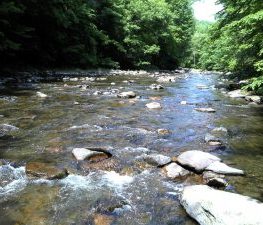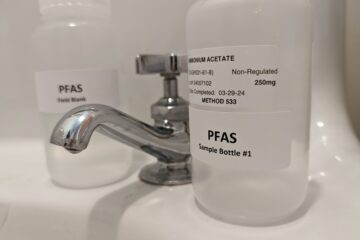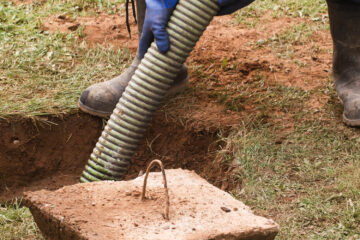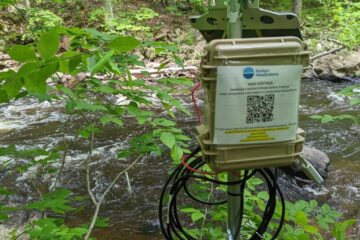 How clean are the waters of the streams that flow through your town and neighborhood? Can you safely wade, swim, fish and paddle in them?
How clean are the waters of the streams that flow through your town and neighborhood? Can you safely wade, swim, fish and paddle in them?
What about the underground aquifers that supply drinking water to 80 percent of local residents? Is it safe to drink the water coming from your well?
These are questions that Raritan Headwaters, a Bedminster-based nonprofit, has been investigating and reporting to the public for almost 60 years through its stream monitoring and well testing programs.
Study also highlights problem areas that need improvement
“Raritan Headwaters is dedicated to being the watershed watchdog looking out for problems affecting our water,” said Dr. Kristi MacDonald, director of science for RHA. “Our region, which includes the North and South branches of the Raritan River, is 470 square miles – and nobody else does what we do to protect it.”
For decades, Raritan Headwaters has collected annual data at established sites on streams and rivers, including information about the water’s benthic macroinvertebrates, chemistry and habitat. In 2017, Raritan Headwaters sampled water at 67 stream sites throughout the watershed with the help of trained volunteer “citizen scientists.” At their State of Our Watershed conference in December they released the first Watershed Report Card as what they hope will become their annually updated report on water quality.
2017 Stream Health
Raritan Headwaters’ 2017 “Report Card” for the region shows that river and stream health was mostly good, although it also highlights areas of concern that need to be addressed.
“Because we have been monitoring the same locations over many years, we can see how agriculture, urban land use, loss of forest and weather events like droughts and storms have impacted water quality,” said Dr. MacDonald. “Understanding of the stressors will allow us to work with partners to protect and restore healthy streams and rivers.”
The report card is largely based on a scale called the High Gradient Macroinvertebrate Index (HGMI), which tests for the presence of tiny crustaceans, worms and insects in streams and rivers. Some of these creatures, like stoneflies, are highly sensitive to pollutants and will die off when waters are contaminated. The scale assigns a rating of excellent, good, fair and poor to water quality depending on which species are found there.
The Upper Raritan watershed covers parts of Hunterdon, Somerset and Morris counties. In 2017, the average HGMI water quality rating in the northwestern sections of the watershed was “good.” However, the eastern and southern sections – specifically, the North Branch and the Neshanic rivers – averaged only “fair.”
“As a headwaters region, our water quality should be ‘excellent’ because millions of people in the watershed and downstream in urban areas of the state are drinking the water originating in our streams and aquifers,” says Angela Gorczyca, water quality manager. “So there is still much room for improvement.”
As a whole, streams within the watershed received an “A” grade on several other indicators of health, including temperature, dissolved oxygen, habitat, pH and turbidity. But they dropped down to a “C” for bacteria and nitrates, and a “D” for phosphates.
Residents Can Make a Difference
“We’ve seen the data,” said Dr. MacDonald. “The important thing now is to do something about it. People in our watershed can make conscious decisions in their homes and communities that affect water quality.”
Major stream pollutants include pet waste, faulty septic systems, manure from farm animals and droppings from wild geese. Other causes of stream impairment include road salt, litter, chemical fertilizers and pesticides, and chemicals from sources like old dumps.
What can watershed residents do to help? Among the many actions residents can take to improve the health of their local streams and aquifers are:
- Pick up and dispose of dog waste
- Inspect and maintain home septic systems
- Test home wells annually for bacteria
- Properly store farm animal manure
- Don’t feed wild geese that congregate around ponds and riverbanks
- Maintain and restore forested buffers around streams and ponds
- Install green infrastructure like rain gardens and plant trees to filter runoff water
- Limit the use of harmful chemicals, including some cleaning products, pesticides and herbicides
- Preserve forests
- Conserve water
Area residents, businesses, golf courses and schools that want to do even more to protect water quality are encouraged to become certified as “River Friendly.”
The program – a partnership between Raritan Headwaters, the Stony Brook-Millstone Watershed Association and the NJ Water Supply Authority – works to reduce pollution, conserve water, restore habitat for wildlife and educate the public about becoming better environmental stewards.
For more information, visit the River Friendly website .
Local residents with an interest in citizen science can also volunteer to become a stream monitor during the 2018 season. Free training is scheduled for new volunteers on Saturday, May 5th. For more information, contact Angela Gorczyca, water quality manager, at agorczyca@raritanheadwaters.org or 908-234-1852 ext. 315.
Well Testing
In 2017, Raritan Headwaters helped over 3,500 owners of private wells get their water tested at affordable prices through a private laboratory.
“Everybody with a well should get their water tested once a year, because it’s the only way to know your water is safe to drink,” said Mara Tippett, well test manager. “If your water is found to be contaminated, it can be treated to filter out pollutants.” Residents on municipal water supplies should also test for lead because that is associated with the pipes.
Individual water test results are confidential, but data collected through the well testing program is used by Raritan Headwaters to track groundwater quality trends over time. RHA has been collecting and analyzing data for over 30 years.
The most common well tests are for coliform bacteria and nitrates from faulty septic systems. In 2017, bacteria were found in 7 percent of the tests conducted. Failing levels of nitrates were found in only 1 percent of the tests conducted, although traces were detected in another 11 percent.
Arsenic, a naturally-occurring groundwater contaminant in the Raritan Headwaters region, was detected in 54 percent of the nearly 1,500 tests conducted. Fourteen percent of the tests showed failing levels of arsenic, while 40 percent had arsenic present that did not exceed drinking water standards. Arsenic is associated with negative health effects including various cancers and heart disease.
To find out how to test your well water, go to https://www.raritanheadwaters.org/get-involved-2/groundwater-well-testing/ or contact Tippett at welltesting@raritanheadwaters.org or 908-234-1852 ext. 401.



